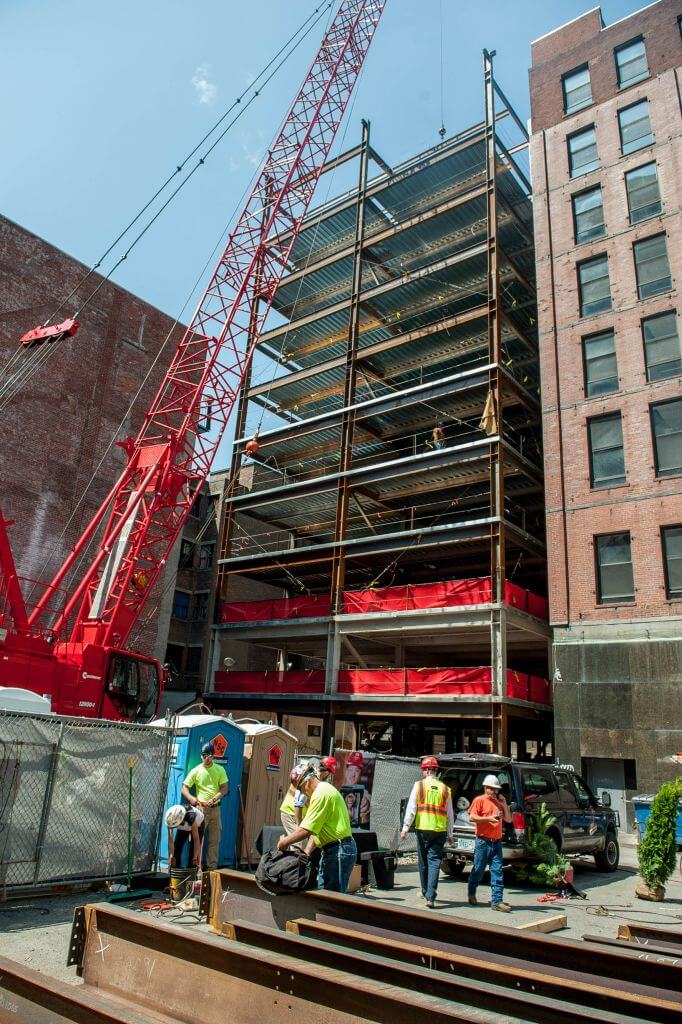Explore the various job opportunities within each category to find out what each design & engineering job entails, what you’ll need to know to build your own construction career and to see how much you could earn!
 Nature of Work
Nature of Work
The role of an architect involves numerous job descriptions including production drawings, design, specifications, construction document production, computer-aided design, and project management. These tasks apply to design in many different types of fields such as building, energy conservation, historic preservation, interiors, site planning, facilities management, landscape design, graphics, and urban planning. The design element of architecture requires sensitivity to the environment. Architects learn to discover new and creative ways of problem solving under diverse and changing conditions with known and unknown constraints.
Education and Training
It is important to apply early to a school of architecture (accredited by the National Architectural Accrediting Board), as admission is often competitive. The bachelor degree involves a five-year undergraduate and graduate program, or a four-year liberal arts degree (undergraduate), followed by a two to three-year graduate degree. Advancement Potential Advancement within the field of architecture often involves becoming a registered architect. This is accomplished by passing a state board licensing test which can be taken after fulfilling certain obligations (which vary from state to state). The obligations typically include internship for at least a three year period under a professional architect. At the upper levels of advancement, there are job opportunities such as firm management, business development, and marketing. Aptitude and Interest The architect needs to prepare for his or her career in high school by taking a broad range of courses which should include art, English, history, social studies, mathematics, physics, foreign languages, business, and computer science. It is helpful to have freehand drawing skills as well as rudimentary drafting ability and an interest in the natural and built environments.
Click here to learn more about all of the educational opportunities in the Boston area
 Nature of Work
Nature of Work
A draftsman translates a designer's ideas into a finished picture using drawing and drafting skills. The drawings produced will be used as a guide by every other link in the chain of construction, both on-site and in the office. The draftsman must be detail-oriented and skilled in free-hand and mechanical lettering and drawings, and should have good hand-eye coordination.
Education and Training
Drafting courses taught in high schools, vocational-technical schools, and other training institutions are a minimum requirement. Draftsmen need a good background in math, including geometry and trigonometry. Any classes which teach the basics of mechanical drawing, lettering, and blueprint reading will be useful. Draftsmen may wish to seek additional study in mathematics and computer- aided design in order to keep up with technological progress within the industry.
Advancement Potential
There are numerous areas of specialization within the field of drafting, many of which lead to greater opportunity for performing actual design work. Since some firms frequently employ several draftsmen, there is potential for a management position within the drafting crew. With additional training, draftsmen may become recognized engineering technicians - individuals whose primary function is to provide technical support to the designers and engineers who work in construction.
Click here to learn more about all of the educational opportunities in the Boston area
Nature of Work

Michelle Ruda, HVAC Engineer
BR+A Consulting Engineers, Boston, MA
Engineers in construction are involved in planning, design, construction, operation, and management of engineering and engineering-construction projects. They are problem solvers, and must be concerned with both the detail and general applications and problems of their work in relation to the overall construction project. Engineers in construction may specialize in several engineering fields such as architectural, civil (including structural engineering), electrical, mechanical, and environmental engineering.
Engineers in construction are involved in planning, design, construction, operation, and management of engineering and engineering-construction projects. They are problem solvers, and must be concerned with both the detail and general applications and problems of their work in relation to the overall construction project. Engineers in construction may specialize in several engineering fields such as architectural, civil (including structural engineering), electrical, mechanical, and environmental engineering.
Types of Engineers:
Architectural Engineer
The architectural engineer (AE) is involved with the design of the building, and/or the estimating and supervision of the project. Initial emphasis is on building construction materials, principles, practices, and methods. An AE can specialize in structural design or in building environmental system design of heating, ventilating, and air conditioning; fire safety systems; plumbing; or lighting/illumination. In college, the AE program is clearly focused on the building industry.
Civil Engineer
Civil engineers work with structures. They design and monitor the construction of roads, airports, tunnels, bridges, dams, harbors, irrigation systems, water treatment and distribution facilities, and sewage collection and treatment systems. Civil engineers are technical problem solvers. They incorporate the principles of science and mathematics into the cost-effective design of permanent and temporary structures. The development of detailed plans and specifications is a major aspect of their work. Civil engineering is the oldest and broadest of the engineering professions. “Civils” can concentrate their work in technical specialties such as structural engineering and transportation engineering.
Structural Engineer
Structural engineering is a specialized field of work falling within the civil engineering discipline. Structural engineers are planners and designers of buildings of all types: bridges, dams, power plants, supports for equipment, special structures for offshore projects, transmission towers, and many other kinds of projects. They are experts in analyzing the forces that a structure must resist (its own weight, wind, water, temperatures, earthquakes, and other forces), and incorporate appropriate materials (steel, concrete, timber, plastic) into a design that will resist these forces and carry the total load of the structure.
Electrical Engineer
Electrical and electronics engineers design, develop, test, and supervise the manufacture and sometimes installation of electrical equipment. Such equipment includes the power generating and transmission equipment of electric utility companies, and the electric motors, machinery controls, and lighting and wiring used in buildings. Electronic equipment used in automobiles, aircraft, computers, and communications equipment is also designed by electrical engineers.
The work involves writing equipment performance requirements, developing maintenance schedules, solving operating problems, and estimating the time and cost of electrical engineering projects.
Mechanical Engineer
Mechanical engineers are concerned with the production, transmission, and use of mechanical power and heat. They study the behavior of materials when forces are applied to them—such as the motion of solids, liquids, and gasses—and the heating and cooling of objects and machines. Mechanical engineers design and develop manufacturing equipment and technologies, and supervise installation of refrigeration and air conditioning equipment, materials handling systems, automatic control systems, noise control and acoustics, machine tools, internal combustion engines, solar energy systems, and rail transportation equipment.
Environmental Engineer
Environmental engineers design, plan, or perform engineering duties in the prevention, control, and remediation of environmental health hazards utilizing various engineering disciplines. Work may include waste treatment, site remediation, or pollution control technology.
Education and Training
Construction-oriented positions in modern engineering range from those requiring a bachelor’s degree to those requiring a master’s degree. University entrance requirements are generally those which a high school college preparatory program provides. Interested individuals should contact the admissions office at their selected college for specific details. Seek a school accredited for the specific type of engineering program desired. Good SAT or ACT scores are important, as well as good grades in junior high school and senior high school.
Aptitude and Interest
Students with an aptitude for engineering are probably earning above average grades in mathematics and science. Above all, they should enjoy these subjects, and like to study and to achieve. Engineering students should have common sense, patience, and a strong sense of curiosity.
Advancement Potential
There is a place for engineers of many kinds of interests and abilities within the construction industry. Many engineering graduates begin as assistants to supervisors, office managers, or company executives. All have the potential to move into top management positions. Many construction firm owners began their careers as design engineers.
Click here to learn more about all of the educational opportunities in the Boston area
Career Options


 Nature of Work
Nature of Work Nature of Work
Nature of Work